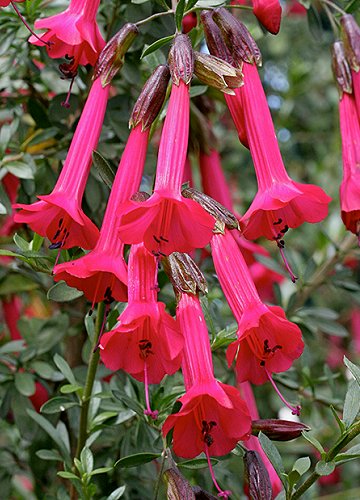
|
|
Sacred Flower of the Incas
(Cantua buxifolia).
Flowers.
|
Sacred Flower of the Incas - Cantua buxifolia
Cantua buxifolia (Sacred flower of the Incas), hispanicized spellings
Cantuta, Ccantu, known as Qantu, Qantus or Qantuta (Quechua), is a flowering plant found in the high valleys of the
yungas. It is the national flower of Peru and one of two national flowers of
Bolivia, the other being the patuju. The Bolivian national flower is in fact a particular variety of
qantuta, the "qantuta tricolor" which has red petals, a yellow floral tube and a green
calyx, reflecting the colors of the national flag.
An upright shrub that grows about 6' high with erect stems and arching branches holding small (1/2 to 1 inch
long) semi-succulent gray-green leaves. In spring appear a profusion of orange to magenta pink flowers that have a long tube with a flaring mouth held on thin pedicels so the flowers dangle beneath - our form is a saturated orange
color.
Plant in full sun to light shade in a well-drained soil with regular to occasional
irrigation. It is hardy to around 20 F but apparently dislikes hot inland
conditions. In its natural habitat it is pollinated by hummingbirds so is a good plant to bring these birds into one's
garden. It can be outrageous in bloom but is a somewhat untidy garden plant with a sprawling form and leafless stems so can benefit from staking several branches together and the pruning back of the longer stems but prune only just after flowering as the flowers are produced on the previous season's
wood.
Cantua buxifolia's natural habitat is in the high valleys of the Yungas, the forest along the eastern slope of the Andes Mountains where it can grow to be a small tree to 18 feet
tall. It is the national flower of Peru and one of two national flowers of Bolivia
(the other being Heliconia rostrata). The name for the genus is a Latinized version of the common name Qantu that was used by indigenous Incan people and the specific epithet refers to the resemblance of the leaves to those of a boxwood
(Buxus). Besides the common name Flower of the Inca, this plant also is called
Magic-flower, Magic-flower-of-the-Incas, Magictree, Sacred-flower-of-the-Incas and by the Incan names
Qantu, Qantus or Qantuta.
Considered sacred in Andean cultures, reddish Kantu flowers often are used decoratively during holy
days. Perhaps because of their sizeable, tubular flowers, Kantu is a word also used to describe musical groups that play Andean flutes similar to pan
pipes.
Besides this it is used for colorful ornamentation. Its thin branches are used to make baskets and from its leaves is obtained a yellow
dye. The cantuta also is said to have medicinal properties. People say it fights diarrhea when its stem of leaves are taken as
infusions, as well as cough, jaundice, and inflammation of the eyes.
During the battle, the two kings mortally wounded each other, and were carried away. Each on his dying bed called his son and had him vow to avenge him, even if each son had been opposed to the war in the first place. Bound by their pledge, the sons prepared and led a second war even though they held no grudge against each other. History repeated, and each son inflicted a fatal wound on the other.
The Inca legend associated with the cantua is the tale of two kings named Illimani and Illampu and their sons. Both kings were powerful and wealthy rulers of a vast country in the Qullasuyu region (today's Bolivian Altiplano), and each had a beloved son whom the people held in great esteem. But as time passed, the kings became irritated at each other's prosperity, and eventually one of them attacked the other.
But instead of harsh words, the dying sons generously forgave each other, and asked that their servants place them side by side on the green grass of the battlefield. Then appeared Pachamama, goddess of fertility, who told the young kings before they died that they shouldn't have suffered from their fathers' unjustified enmity. To punish their dead fathers, their stars fell from the sky and became the snow-covered mountains still named Illimani and Illampu which are some of the highest peaks in Bolivia.
The rivers of their slowly melting snow are their tears of regret and fertilize the valleys. The cantua bloom symbolizes the people's unity, and bears the colours of the two kings' sons (red and yellow), as well as green (standing for hope).
Source:
https://en.wikipedia.org/wiki/Cantua_buxifolia
http://www.smgrowers.com/products/plants/plantdisplay.asp?plant_id=4004
http://www.fbts.com/cantua-buxifolia.html
http://cuzcoeats.com/flor-de-inca/
